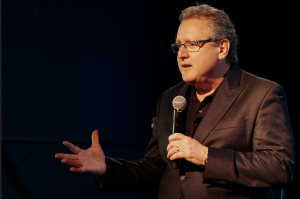
By Mark Schaefer
Here’s the current state of my advertising consumption.
- I subscribe to digital versions of The New York Times, The Wall Street Journal and my local paper. I have not seen a newspaper ad in five years. Maybe longer.
- With the exception of the news or a live sporting event, I never see ads on TV. Nearly all of my video consumption is through Netflix or Amazon Prime.
- I never listen to commercial radio. I only listen to Sirius XM, Spotify, or my iTunes library.
- On principle, I don’t want to engage in ad blocking. However, when I got a virus on my Mac, the easy solution was to install an ad-blocker. No more malware. And no more ads, either.
- The only new place I am exposed to ads is on podcasts, where my consumption has increased over the past few years. I probably see ads on Facebook but I’m “blind” to them.
I estimate that the number of ads I see on a daily basis is down by 90 percent compared to five years ago. If you reflect on your own content-viewing habits, you may come to a similar conclusion.
The fact is, we are inexorably moving toward an ad-free world. Let’s look at five positive impacts of content marketing in this environment.
1. The new provocation
In general, people consider ads as a necessary evil. That’s one of the reasons so many companies are relying on content marketing and its many iterations as a primary way to connect to consumers today.
Our job as marketers is to provide customers, and potential customers, with “provocations” that allow opportunities to engage with the brand. Those provocations create awareness, interaction, and potentially loyalty and trust over time.
Traditionally, those provocations might be ads, coupons or product samples. Today, however, many of those channels are drying up. Consumers will, however, respond to stories and information that helps, inspires, and entertains. That is the core idea behind content marketing today — use content to nurture customer relationships that eventually leads to action.
2. A new mindset for the ad-free world
To achieve greatness in this ad-free environment, we need a new mindset. We need to change from “sell, sell, sell” to “entertain,” “captivate, or “help, help, help.” That’s very difficult to do because we have been programmed for decades to sell. Our internal quarterly and annual goals are based on higher and higher sales objectives. So, we have a lot of obstacles to move to this new mindset.
Many content marketing best practices are still just advertising in disguise and that needs to change. “Lead nurturing” is a kind way to say we’re going to keep bugging you until you tell us to go away. Pop-up ads are so annoying that Google is taking action to penalize sites that use them.
Ultimately, we have to treat people with respect online like we do offline. In the real world, we would not be selling all the time. We wouldn’t demand that a person give us an email address before they came into our store. If somebody needed our help, we wouldn’t demand that they subscribe to a newsletter first.
In the real world we discuss, help, and listen. That’s how you build relationship offline and how you do it online, too.
In an ad-free world, the most human companies will win.
3. Sharing = winning
Content alone provides no value to a company unless it’s seen and shared. That’s why my book The Content Code emphasizes that “social sharing” should be a primary focus of our efforts. Some have characterized social sharing as a vanity metric. They could not be more wrong. A focus on understanding how and why your content moves is not just a strategic priority, it’s an economic priority, as well:
- A study by The New York Times showed that 85 percent of the people who shared content said they better understood the product and the company. They are taking the time to read and understand. They are becoming advocates, and that is the most powerful thing we can hope for.
- Similarly, the same study showed that 70 percent of adults say their purchasing decision is affected by content they see shared on the web. People will trust a review or a comment by a stranger more than they will trust an ad from a company.
- According to research by Boston Consulting Group, one ultra-loyal customer who shares content can generate eight times his or her own consumption through their advocacy.
The key idea here is that the economic value of content marketing does not come from content. It comes from the transmission of content. The Content Code outlines the six possible strategies to achieve that goal. Are you up to speed on this priority?
4. Influence and content marketing
I regard influence marketing as a sub-set of content marketing for the simple reason that on the web, in general the “influencers” we want to work with achieved that position through their content — videos, snaps, photos, and blogs.
In an ad-free world, influence marketing is an indispensable tactic and one of the hottest trends around.
In 2012 I wrote the first book on influence marketing (Return On Influence) and predicted that it would become a mainstream tactic. The reason is simple: Social media has flipped the center of power. Everyone with an opinion and a wifi connection can publish and establish their own niche of power on the web.
The “influencer frenzy” where brands are paying enormous amounts of money to be aligned with a YouTube star or Snapchat queen is really just beginning, and it’s all fueled by content.
5. Content marketing does not replace advertising
I would love to be the one to tell you that a commitment to content marketing will result in happily-ever-after. But it doesn’t. In most cases, it doesn’t work as well as advertising, at least in the short-term. But since we are moving to an ad-free world, that’s not so much of an option any more, is there?
So we are in a new era where we need to consider the content marketing option. It takes time, consistency, patience, and a commitment to quality content to work. Even in a noisy marketing world crippled by Content Shock, there are still plenty of unsaturated niches to find and dominate.
And in an increasingly ad-free world, every business needs to at least consider a role for content marketing in its strategy.
 Mark Schaefer is the chief blogger for this site, executive director of Schaefer Marketing Solutions, and the author of several best-selling digital marketing books. He is an acclaimed keynote speaker, college educator, and business consultant. The Marketing Companion podcast is among the top business podcasts in the world. Contact Mark to have him speak to your company event or conference soon.
Mark Schaefer is the chief blogger for this site, executive director of Schaefer Marketing Solutions, and the author of several best-selling digital marketing books. He is an acclaimed keynote speaker, college educator, and business consultant. The Marketing Companion podcast is among the top business podcasts in the world. Contact Mark to have him speak to your company event or conference soon.
Illustration courtesy of Flickr CC and poster boy


